An update from Jessica:
AJ- 24 months
An update from Janelle:
Emmy- 29 Months
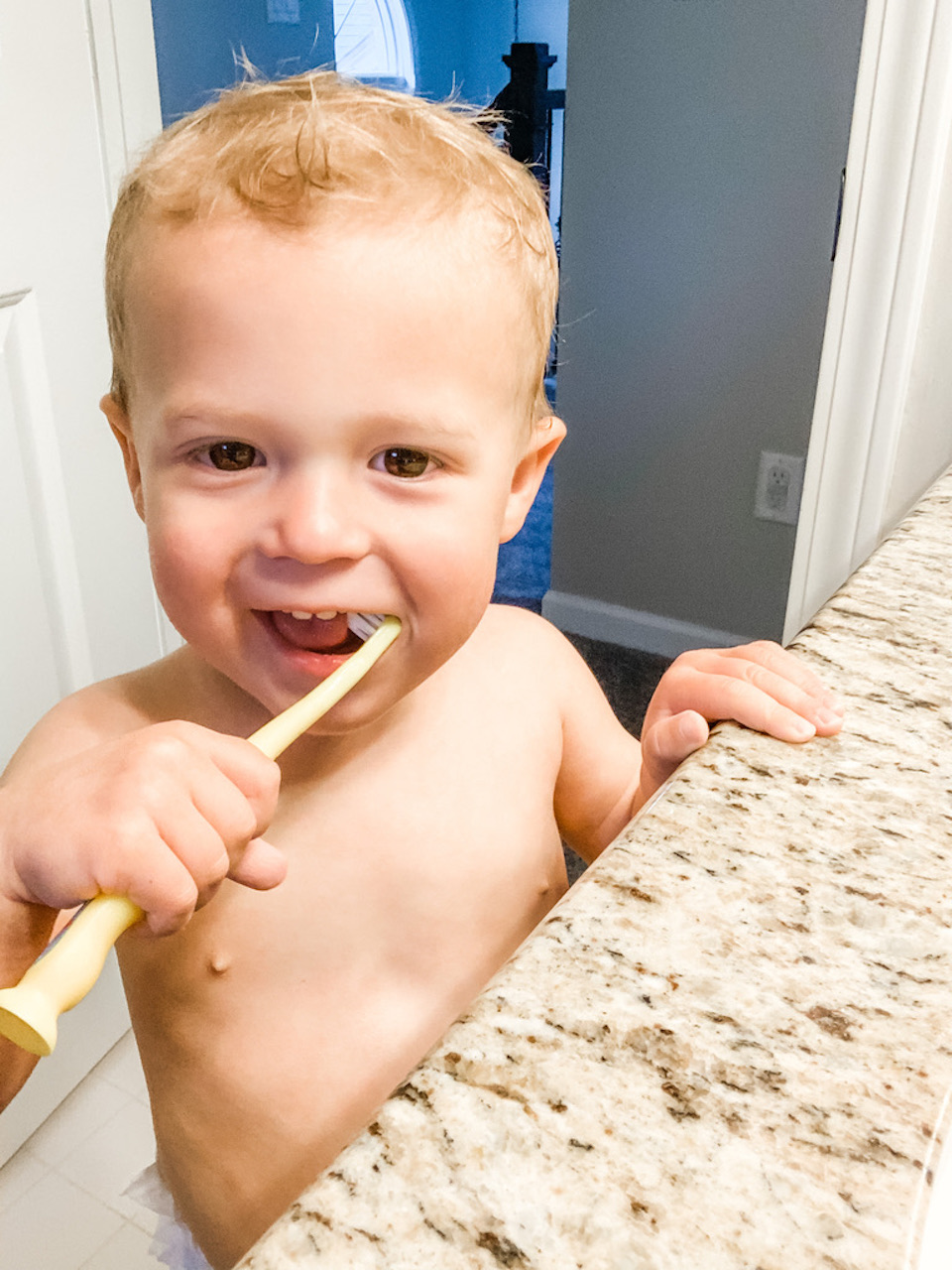
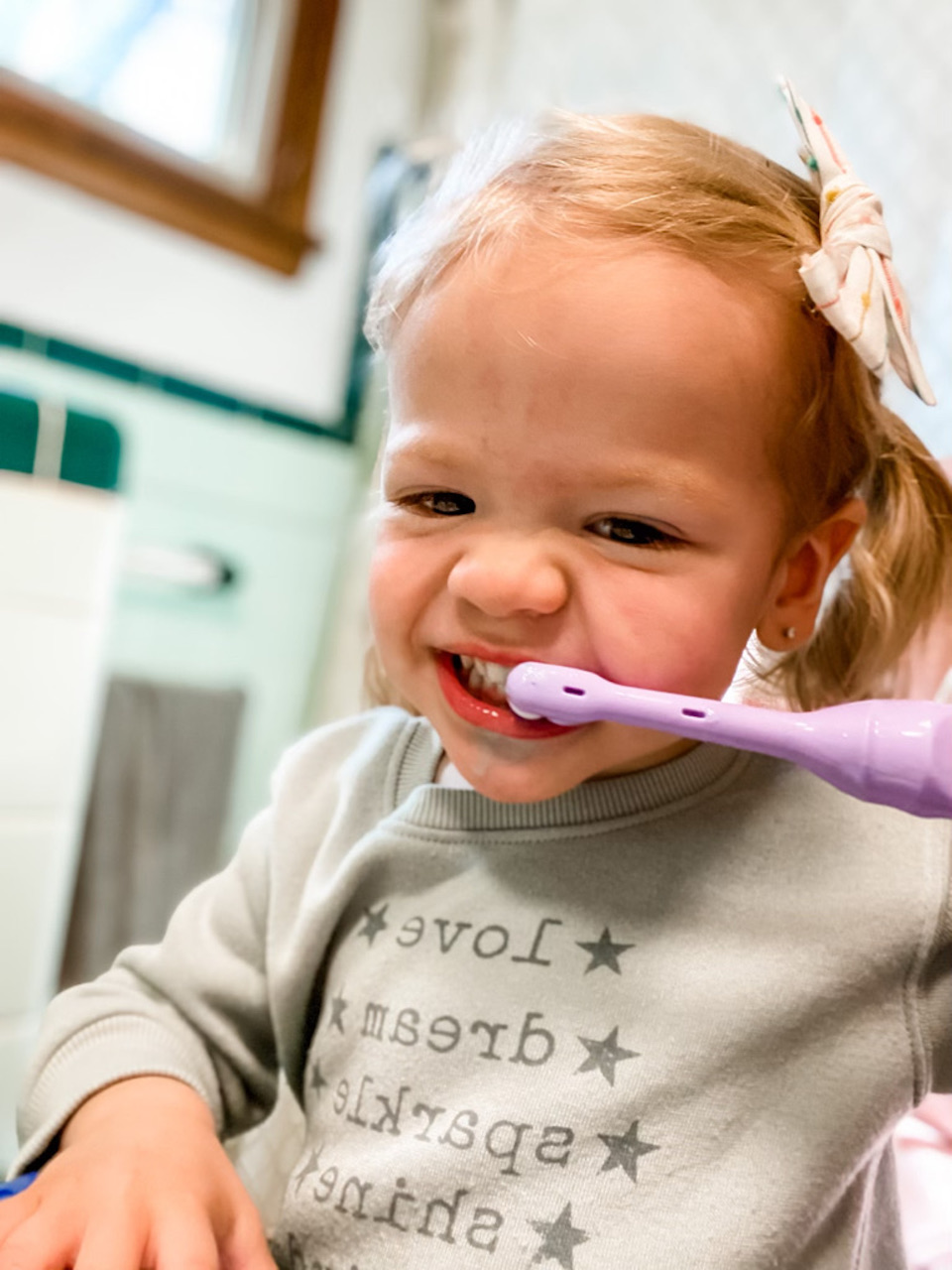
Like many of our routines, toothbrushing has become more challenging since our original post. However, we have been able to overcome most of these challenges by implementing certain strategies and remaining consistent. AJ probably has 10 toothbrushes in our house (not necessary, they have just accumulated between freebies and packs with multiple characters). I do keep one in my bathroom and that is usually where he brushes his teeth in the morning after breakfast as I am getting ready for the day.
For Christmas, AJ got a personalized step stool from Pottery Barn Kids. When he brushes his teeth at night in his bathroom upstairs, this helps him to reach the sink (I do wish I got the version with two steps though, because he is still too short to reach easily!). We also have a Munchkin faucet extender on his sink that I found on Amazon. This helps him to be more independent with rinsing his toothbrush–we love it for handwashing too!
For a while AJ fought us with brushing his teeth. Now (MOST nights) he is willing to attempt to brush his teeth first on his own, then we help him and make sure the ones in the back get cleaned well too! Some things that may have contributed to this improvement:
- Modeling- I model brushing my own teeth in the morning as he is brushing his teeth. He thinks it is SO cool that I also brush my teeth everyday.
- Reading books about brushing your teeth- we have a few favorites I will share below! Even an interactive one–the best kind!
- Choices- just like with eating and deciding what to wear, giving AJ a say within this routine as well helps prevent tantrums and power struggles. This is where the 10 toothbrushes come into play. We certainly do not need 10, but if you even have a couple different toothbrushes then let them decide which character, color, etc. they want to use each night, they will feel more in control and willing to brush!
I hope that by continuing to use these strategies and being consistent with this routine AJ will have healthy teeth and a future of good tooth brushing habits!
Like many two-year-olds I know, Emmy has a love-hate relationship with toothbrushing. Some days she asks to brush her teeth multiple times, and other days she’s kicking and screaming the entire time we’re brushing her teeth. If you also have a toddler that doesn’t love brushing their teeth, you’re not alone. There are a few tricks that we have found that make this daily task a little bit easier:
- Choices- Providing a toddler with choices can make a big difference in their behavior. It helps them feel like they have a say in what’s happening, and that their opinion matters. When it comes to toothbrushing, allowing your child to choose their toothbrush or toothpaste can make a big difference. Emmy has five, yes five, different toothbrushes with various characters that she loves. She also has three different types of toothpaste.
- Allow your child to brush your teeth! Emmy thinks it’s hilarious when she gets to help my husband or I brush our teeth. She is often way more likely to allow us to brush hers if we let her brush ours first.
- Sing songs–We like to sing songs while brushing our teeth. Whether it’s the ABC’s or a silly song that we make up, Emmy knows that when the song is over the toothbrushing stops.
- Practice during play! Have a toothbrush in your child’s pretend play items so that they can have access to it outside of actual brushing times. We like to practice on our baby dolls and stuffed animals.
This past year, she also had her first trip to the dentist. The American Dental Association recommends first dental visits around the age of one. When it comes to first trips to the dentist (or first of anything), preparation is key! When your child knows what to expect, you can ease their anxiety of what might happen in a new situation. We prepared Emmy for her first dental visit by reading lots of books about the dentist (our favorites are listed below), talking about what would happen, and role playing with stuffed animals and baby dolls. Emmy’s first dental appointment went off without a hitch, and she even reported that she wanted to become a dentist when she grows up!
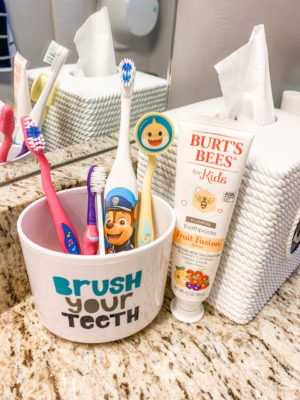
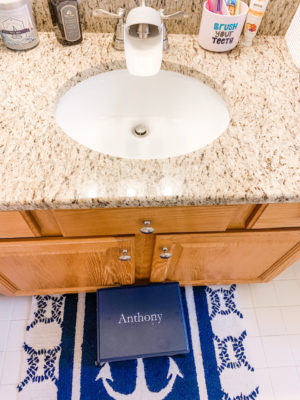
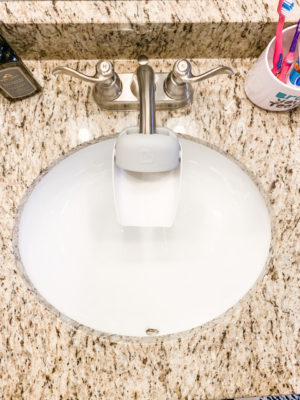
UBAM BOOKS that teach this skill
Of course, if you are having difficulty when it comes to this routine with your child, books can help! Even if your child enjoys brushing their teeth, reading about routines and behavior opens up the door for discussion in a way that your child can understand. Here are some of our favorites from Usborne Books and More:
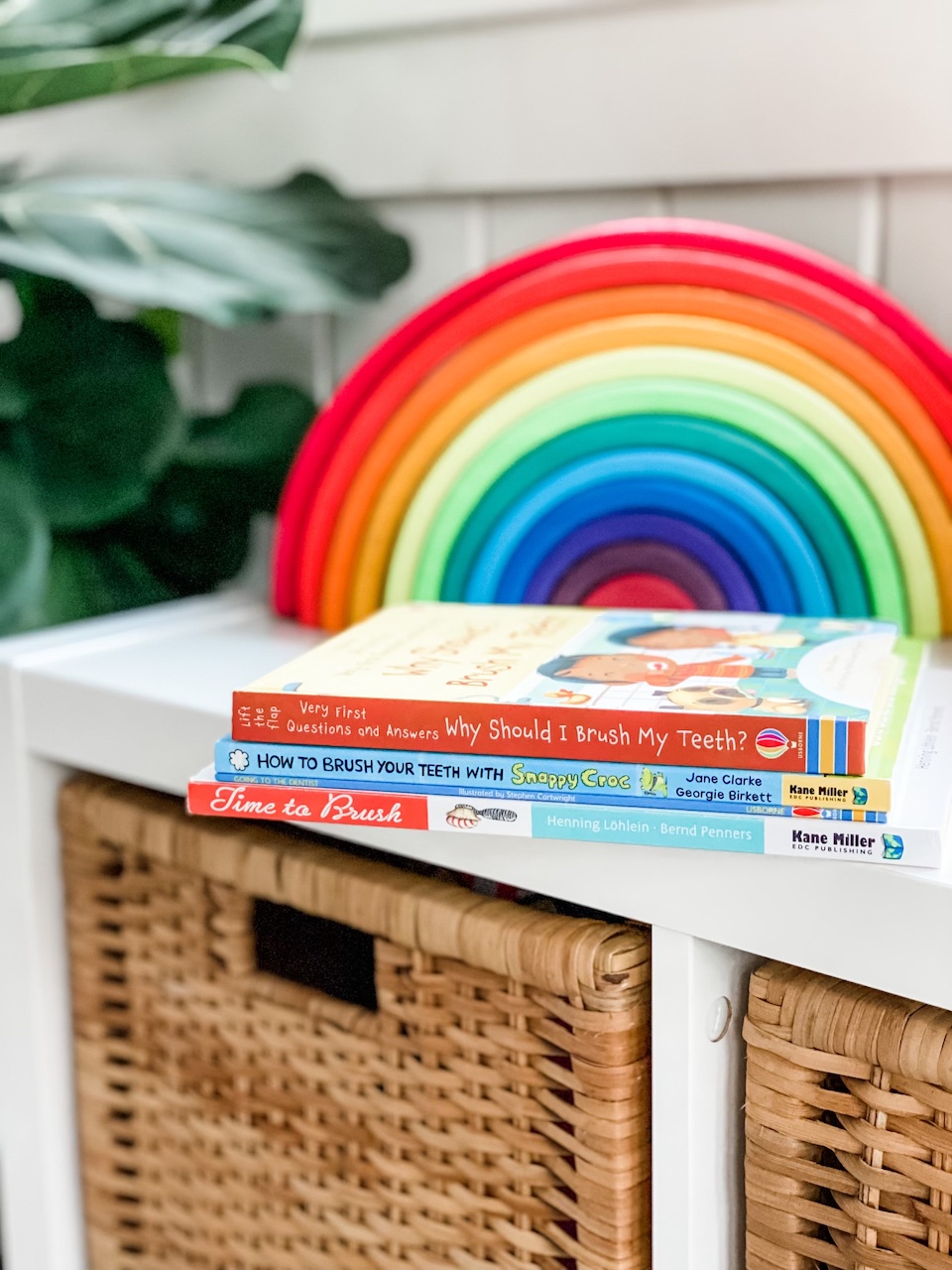
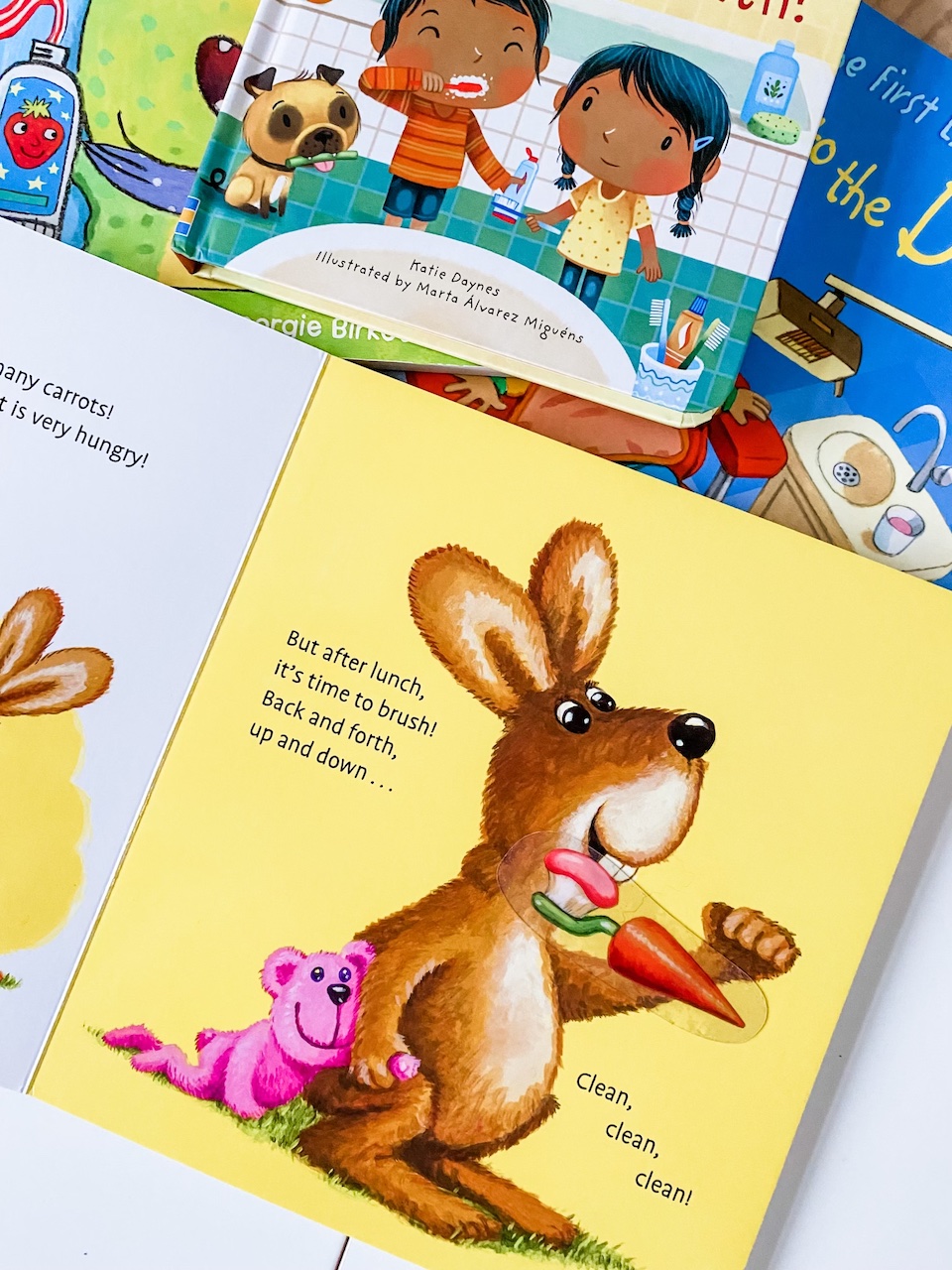
How to Brush Your Teeth with Snappy Croc: This durable board book is a favorite in our home. It has playful, rhyming text, and features a cute little croc who needs to brush her teeth.
Time to Brush: Five animal friends need to brush their teeth! In this book your child will get to find each animal’s matching reusable sticker toothbrush and help them brush their teeth.
Lift-the-Flap Very First Questions and Answers: Why Should I Brush My Teeth?: With over 30 flaps, this interactive book will answer all of your child’s curious questions about brushing their teeth.
Going to the Dentist: This book will introduce your child to different things they will experience during their first visit to the dentist.
Brushing Teeth with Max and Millie: This book is a part of a series that follows two friends, Max and Millie, who learn to become independent with everyday tasks like brushing their teeth!
-Original Post Below-
Hey there! I’m glad you’re back for the next post in the series, “Developing Daily”. To those who are new to “Developing Daily”, it’s a series I’ve been working on in collaboration with Janelle Ritchie of The Play Effect, in hopes of empowering you to support your child’s development through everyday tasks. (If you missed our last post on getting dressed, you can find it HERE!)
Today we’re going to be talking about ways to support your child while brushing their teeth.

Janelle Ritchie is a certified pediatric speech-language pathologist at a private practice in Michigan. She has a sweet daughter named Emmy, who just turned 1. She is passionate about working with toddlers first learning to talk as well as the effect play can have on speech & language development.
You can find Janelle on her blog The Play Effect or on Instagram @the_play_effect.
By incorporating dental hygiene into your daily routine at a young age, you will promote independence with brushing and building healthy habits along the way. Here are some ideas on how to support your child’s development while brushing their teeth:
HOW TO SUPPORT social-emotional SKILLS WHILE BRUSHING TEETH:
Make brushing your teeth fun by allowing your child to pick out their own toothbrush at the store. By giving your child a decision of what toothbrush they will use, they will feel empowered and gain a sense of independence.
Discuss the connections between brushing your teeth at home and going to the dentist. The more your child understands about how healthy dental hygiene at home can result in positive dentist visits, the more likely they will be to follow through with daily teeth brushing and flossing.
How to support language skills while brushing teeth:
Build your child’s vocabulary while brushing their teeth. Talk about body parts (teeth, tongue, lips, jaw, etc. ) and items that you find in the bathroom (sink, bath tub, toilet, toothbrush, toothpaste, soap, etc.) while you are brushing their teeth. By labeling things in their everyday environment, they will build their vocabulary of these items faster!
Work on prepositions (over, under, top, bottom, back, forth, in between, etc.) during teeth brushing. Give your child directions such as, “brush the top of your tongue” or “brush behind your front teeth.”
Teach your child sequential language (first, then, next, last). Talk about the steps it takes to brush your teeth using transition words (First, put the toothpaste on the toothbrush. Then put your toothbrush under the water. Last brush your teeth). Then encourage your child to tell you the steps back.
How to support cognitive skills while brushing teeth:
Teach counting skills by counting the number of teeth your child has.
Build your child’s knowledge of colors by discussing the colors on your child’s toothbrush and the color of the toothpaste.
How to support fine motor skills while brushing teeth:
Support your child’s fine motor development by encouraging them to work on using a toothbrush outside of actual teeth brushing. Consider giving them a tooth brush to practice scrubbing or to use during water play!
How to support play skills while brushing teeth:
Encourage your child to practice brushing their baby doll’s teeth using a spare toothbrush, a toothbrush specifically made for baby dolls like this one or a totally different object that they pretend is a toothbrush!
Play “dentist!” Have your child pretend to give you a dental checkup, and then pretend to give your child one back. Not only is this a great way to get them comfortable with going to the dentist, but it’s also a perfect way to build their imaginative play.
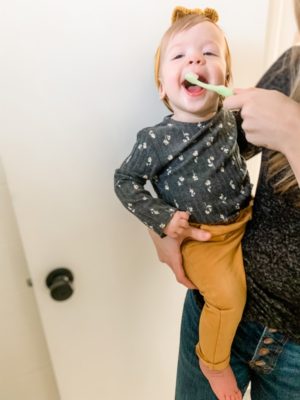


What do I do if my child has difficulty while brushing their teeth?
Here are a few troubleshooting tips:
If your child is working towards brushing their teeth independently:
Model it! Have your child watch you brush your teeth so they can watch exactly how it’s done. Children learn best from our models so they will develop their skills further by watching you.
Provide hand-over-hand support while your child is refining their fine motor skills required to brush their teeth effectively. This consists of you controlling their hand with yours as they hold the toothbrush. This enables them to build muscle memory and because they are holding the toothbrush, they maintain some control.
Make sure your child can reach the sink and counter! Place a stool, like this one, at the base of your vanity to ensure your child can see his/herself in the bathroom mirror. Visual feedback can be a powerful thing when learning new tasks!
IF YOUR CHILD gets distracted easily:
Provide your child with visuals to help them remember the steps to follow when brushing their teeth. Keep the visuals handy, or even place them on the bathroom mirror so that they are always visible to your child when in the bathroom.
Sing a song while brushing your child’s teeth. Singing will help them attend to the task, while also building vocabulary and auditory memory skills. Try singing this song to the tune of “Row, Row, Row Your Boat”: “Brush, brush, brush your teeth, all around your gums, merrily, merrily, merrily, merrily, brushing’s so much fun! Brush, brush, brush your teeth, brush them everyday, the front, the sides, the back, the top, to keep the germs away!”
If your child protests brushing their teeth:
Make it fun! Have them pick out their own toothbrush or buy them a toothbrush that has their favorite character or color on it.
Create a teeth brushing chart and place it on the bathroom mirror. Have them put a sticker on their chart each time they brush their teeth.
Make it a family affair. Brush teeth with your child, so they understand that they’re not alone and it’s something everyone has to do.
Try using first, then language. For example, “first brush your teeth, then go to school.” By using this type of language, our children will know what they can expect after they brush their teeth.
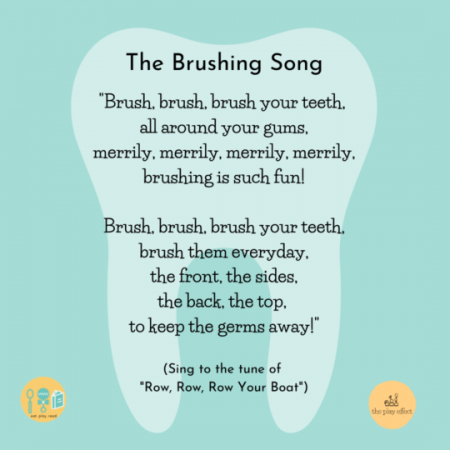
What else can you do to support your child’s teeth brushing skills?
Read books about brushing teeth! These are some of our favorites:
- The Tooth Book by Dr. Seuss
- Tooth by Leslie Petricelli
- The Brushies Baby & Toddler Toothbrush & Storybook Set
- The Tooth Book: A Guide to Healthy Gums and Teeth by Edward Miller
- Caillou: I Can Brush My Teeth by Sarah Margaret Johanson
Play with toys to facilitate teeth brushing skills:
- Crocodile Dentist: This fun game encourages children to check out the crocodile’s teeth while watching out for his sore tooth. When they find it, he might chomp down!
- Practice brushing the teeth of your baby dolls! Grab an extra toothbrush just for your child’s doll, or purchase one specifically made for dolls…We love this adorable one! Pair it with your child’s baby doll, or one of our favorite baby dolls,Wee Baby Stella from The Manhattan Toy Company.
- Be creative with play-doh or legos and practice “flossing” in between pretend teeth.
- Use washable paint on a laminated mouth or plastic tray. Have your child use a toothbrush to brush the dried paint away!

What else can you do to support your child’s dental hygiene?
Promote healthy eating and regular trips to the dentist!
Minimize the amount of sugary drinks your child consumes.
Begin using teethers at a young age. Not only do teethers provide comfort when new teeth decide to show up, but they also introduce the oral cavity to sensations it will encounter during teeth brushing and feeding. By using teethers, your baby will learn to tolerate and discriminate between sensations within the mouth. We linked a few of our favorite teethers below!
Be mindful about pacifier use. While there is no clear research about the effect of pacifier use on speech and language development, we do know that it is essential for children to practice vocalizing sounds without having the pacifier in the way. The American Academy of Pediatrics recommends pacifier use until at least six months of age during sleep to reduce the risk of Sudden Infant Death Syndrome (SIDS) and discontinuing pacifier use after one year of age as prolonged use has been linked to middle ear infections and dental misalignment. The American Dental Association (ADA) recommends that children should stop pacifier use by the age of 2.
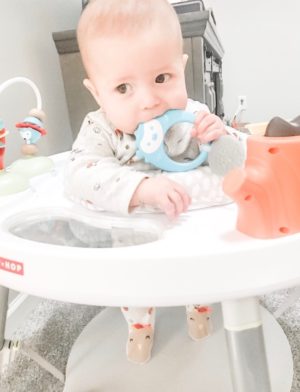
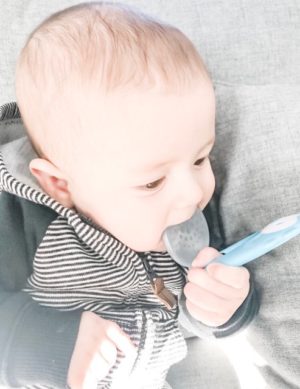
Do you have ways that you help your child while brushing their teeth? We would love to hear them! Feel free to leave them in the comment section below!
*Disclosure: I may earn a small commission for my endorsement, recommendation and/or any link to products or services from this website. Your purchase helps support my work in bringing you valuable content regarding play and it’s impact on child development.
